“Black Paintings” by Francisco Goya – Goya’s Black Paintings
Francisco Goya’s Black Paintings comprise 14 artworks that were produced from 1819 to 1823. These dark paintings depict unsettling themes that reflect both his fear of going insane and his negative outlook on humankind. They were produced in Quinta Del Sordo, and include terrifying and disturbing works such as Saturn Devouring His Son (1823). Read below as we explore the Spanish artist Francisco Goya’s Black Paintings period.
Contents
- 1 The Black Paintings by Francisco Goya
- 2 The History of the Black Paintings by Francisco Goya
- 3 The Original Setting of Goya’s Black Paintings
- 4 Questions over the Authenticity of the Dark Paintings at Quinta Del Sordo
- 5 Themes and Motifs Present in Goya’s Black Paintings
- 6 The Significance of Francisco Goya’s Black Paintings
- 7 How Goya’s Black Paintings Differ from His Other Works
- 8 Reception to Goya’s Black Paintings
- 9 Frequently Asked Questions
The Black Paintings by Francisco Goya
By the year 1819, the Spanish artist Francisco Goya had experienced many intense situations. He experienced the devastation of war after Napoleon attacked Spain, as well as the upheaval in Spain when its government shifted from a constitutional to an absolute monarchy. He’d been critically ill several times, and he believed that he was going insane. One of his conditions had rendered him deaf. Francisco Goya then moved into a residence called la Quinta del Sordo, just outside of Madrid, as he grew increasingly disdainful of people and fearful of death and madness.
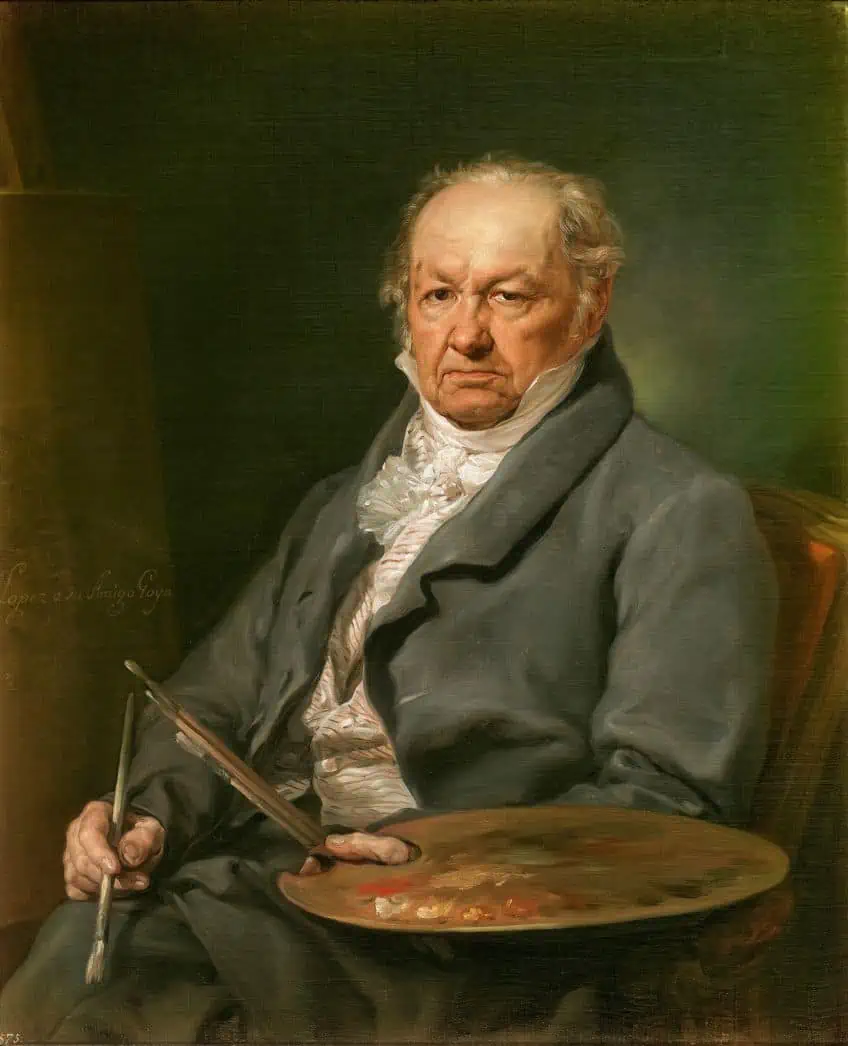
Goya proceeded to produce very dark artwork there. They were painted straight onto the house’s walls, and apparently, Goya never mentioned them to anyone. Goya’s Black paintings contrasted considerably with his previous works and were clearly designed for his personal gratification. He never gave them names, but art historians have subsequently given them descriptive labels. They are known collectively as the Black Paintings by Francisco Goya. While these dark paintings were initially created as murals on the house’s walls, the owner Baron Frédéric Émile d’Erlanger subsequently “hacked” them off the walls and mounted them onto canvas. They are currently on display at the Museo del Prado in Madrid, Spain. Francisco Goya produced these dark paintings by using oil paints and painting directly on his dining and sitting rooms’ walls.
Goya’s Black Paintings were not commissioned, and they were never intended to leave his house or be seen by the general public.
The History of the Black Paintings by Francisco Goya
In February 1819, Goya purchased the Quinta del Sordo mansion on the Manzanares river banks, with beautiful vistas of the vast plains of San Isidro. It has been claimed that he purchased the property in order to avoid attention from the public; he resided there with his maid Leocadia Weiss, with whom he is suspected of having a relationship, despite still being married to Isidoro. It is unclear when Francisco Goya first started working on these dark paintings. It is believed that he may have begun work on the wall paintings sometime between February and November 1819 when he became very ill.
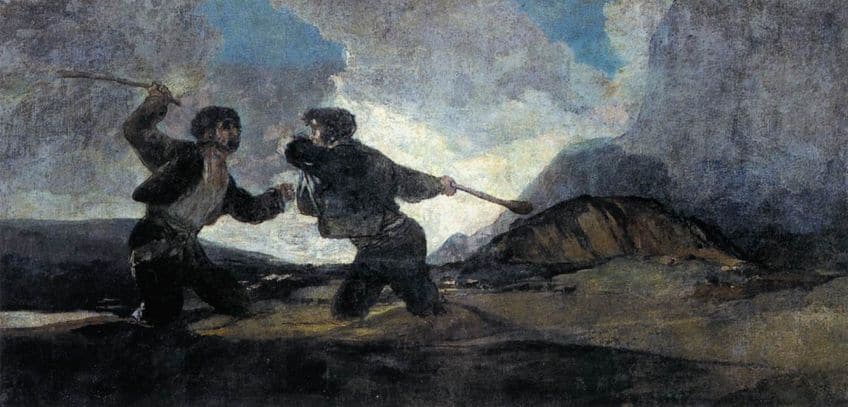
What we do know is that these murals were painted over already existing rural landscapes featuring little individuals, since Goya incorporated these landscapes into several of his murals. If these pre-existing paintings were also the work of Goya, it’s possible that his illness and the turmoil of the Trienio Liberal inspired him to start painting over them. Some have speculated that those original paintings were also created by Francisco Goya, as this is the only explanation for why he incorporated them into the paintings that eventually covered them. Others, though, believe these other paintings were already on the walls of Quinta del Sordo when he bought the place.
Whatever the reality is, Goya’s Black Paintings were most likely completed no later than 1823, when the Spanish artist offered the villa to Mariano, his grandson, possibly due to his apprehension over retaliation after the downfall of Rafael Riego.
In 1830, Mariano de Goya handed possession of the home to his father, Javier de Goya. In 1874, the difficult task of transferring the paintings onto canvas started. Goya had painted his dark paintings on top of a layer of wallpaper that had to be painstakingly extracted and then transferred onto canvas. The project was carried out under the direction of Salvador Martnez Cubells at the instruction of Baron Émile d’Erlanger, a French financier of German ancestry who wished to display them at the 1878 Paris World’s Fair. Goya’s black paintings, however, were gifted to the Spanish state by the baron in 1881.
The Original Setting of Goya’s Black Paintings
The inventory of the paintings compiled by Antonio Brugada includes seven ground-floor murals and eight upper-floor murals. Only 14 dark paintings arrived at the Museo del Prado, though. When Charles Yriarte visited the villa in 1867, the work of art had already been removed and transported to the Marquis of Salamanca’s Vista Alegre Palace. Many scholars believe that this missing mural must be the one known as Heads in a Landscape, which is presently in the collection of Stanley Moss in New York.

Written remarks detailing the placement and initial state of the murals, as well as a photographic inventory taken by Jean Laurent in 1874, provided information on the works’ original layout. Baron d’Erlanger commissioned the photos to be taken when he hired Martnez Cubells to transfer the works of art to canvas. Laurent’s images perfectly captured the steps of transferring these famous dark paintings. Prior to the transfer, art historians had been apprehensive for at least 10 years that rising property prices in the neighborhood would lead to the villa’s reconstruction and the eventual destruction of Goya’s Black Paintings.
The paintings were enclosed by borders decorated in classicist style, as were the windows, doors, and the frieze above the entry, as shown in Laurent’s photos.
The walls were papered, as was customary in aristocratic homes, likely with the Royal Painted Paper Factory’s wallpaper, which Fernando VII patronized. The bottom floor’s wallpaper had been adorned with illustrations of fruit and leaf patterns, while the first floor’s wallpaper was decorated with geometric patterns arranged in diagonal lines. The photos also illustrate the condition of the artworks before they were transported, revealing, for instance, that Martinez Cubells failed to preserve a big portion of the right-hand side of Witches’ Sabbath.
Placement of the Artworks in Quinta Del Sordo
Despite its somber reputation, not all of these artworks were depressing or horrifying. Although almost everyone nowadays associates these works with the terrifying image of the god Saturn devouring his own son or the ruthless duel with cudgels, there are art pieces in the set that are devoid of terror, such as the exquisite figure of Leocadia, stylish and tranquil in spite of her mourning dress. Furthermore, the chambers, with their abundance of windows opening onto the Madrilenian landscape, received a significant amount of sunshine, suggesting that the Quinta Del Sordo was far from the grim location that some historians tend to portray.
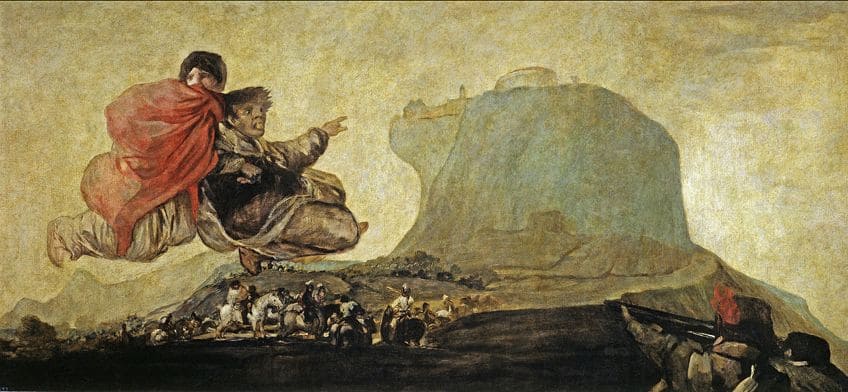
The existence of these windows in the walls served to facilitate the placement of the paintings throughout the rooms. The ground level hall featured two windows in each of its broad walls, whilst the upper story hall had just one. This permitted the Spanish artist to paint massive compositions within the lower room’s windows, but in the top room, he was confined to just two smaller murals on either side of each window. Goya created miniature compositions that were somewhat connected to their larger counterparts on the smaller walls, to either side of the entrance or window, and occasionally above them.
The Lower Floor Artworks
The bottom floor was dominated by two large sets of artworks. Judith and Holofernes came first, followed by Pilgrimage to San Isidro. It has been interpreted in a couple of ways: first, as a warped version of the renowned Madrilenian festivity that used to be held just a few kilometers from the Quinta Del Sordo. However, there is evidence suggesting that it is related to the Roman Saturnalia, which is devoted to the Roman deity Saturn. Another work there, Two Monks, may be connected to the tragic lives of individuals who were driven out after the War. Judith and Holofernes, on the other hand, refers to a well-known Biblical narrative.
This image is oddly comparable to Saturn Devouring His Son, which depicts another maimed figure.
The Witches’ Sabbath would have been located in front of these artworks. This was possibly the most significant painting in the Quinta Del Sordo, yet when the mural was moved to canvas, a large portion of the right end was destroyed, resulting in an odd asymmetry between the small seated female and the big he-goat. In contrast to Saturn’s explicit horror, we would discover the peace of Leocadia, lovely and calm despite her probable link with the departed person who lies in the grave beside her.
The Upper Floor Artwork
There were seven paintings on the upper floor of Quinta Del Sordo. First and foremost, we encounter The Dog, an isolated artwork positioned next to a door. This is possibly the most intriguing image in the residence. It portrays a dog with his head partially buried against an ochre background. We don’t know anything more about the subject of the painting or the significance of this mural. Is he sinking, or is he sticking his head out, warily, fearful of something we can’t see? Many interpretations of this artwork exist, with the dog being associated with the underworld figure who accompanies the deceased souls to Hell and being considered an emblem of desertion and mistreatment.
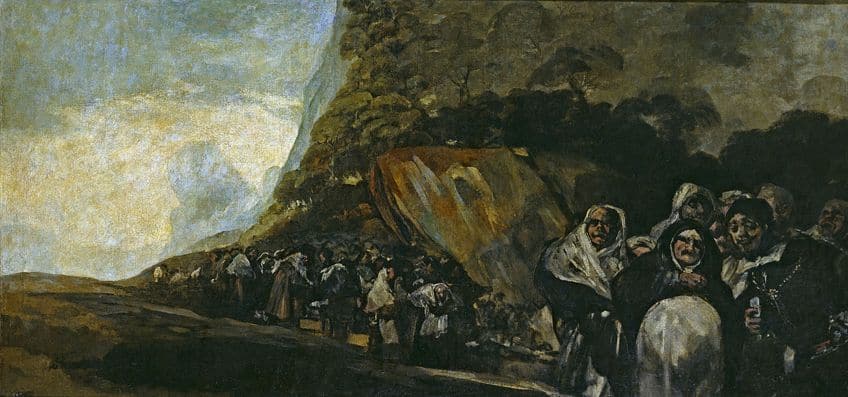
There were two huge murals on the great wall opposite this painting: Procession of the Holy Office and Asmodeo, a mythical killer demon that Goya depicted as a lady who partially obscures her face while hovering in the sky dragging a frightened man. In contrast, Procession of the Holy Office is a bold and satirical criticism of this horrifying Court. There were two additional amazing paintings in front of the previous two: the brutal Duel with Cudgels and the mystical The Fates. The first of them is possibly the most savage of all of Goya’s Black Paintings, yet it is not a mythical or legendary scenario: this conflict is “real”, between two unknown individuals, and it can only be settled by the eventual death of one of them. This composition has been viewed as a Civil War metaphor. In contrast to these two characters, which exist on the ground, the representations of The Fates glide in the air, as do the ones from the Asmodea, which are positioned, certainly not by accident – directly opposite this image. Goya made two vertical artworks, smaller in scale than the previous ones, on one of the top room’s smaller walls: Women Laughing and Reading.
They are clearly less terrifying, although being deeper in color, than the other paintings.
Questions over the Authenticity of the Dark Paintings at Quinta Del Sordo
The legitimacy of the Black Paintings has been called into question by art historian Juan José Junquera. He concluded in 2003 that these works could not have been produced during Goya’s lifetime. According to Junquera, contemporaneous legal papers confirm that the Quinta del Sordo was a one-story home, with the second story only erected after Goya’s death. If this upper level did not even exist at the time of the Spanish artist’s occupation, these famous Black Paintings, or at the very least those located on the upper floor, could not possibly be the work of Goya.

He speculates that the paintings were produced by Goya’s son Javier and that Goya’s grandson Mariano managed to pass them off as Goya’s work for his own financial gain. Junquera’s theories were dismissed by Goya historian Nigel Glendinning, who provided academic research supporting the dark paintings’ validity and later gave a lecture in Madrid to reaffirm his opinion. He drew parallels between these Black Paintings and other Goya artworks, using archival evidence such as an 1812 inventory of Goya’s possessions listed by his son, Javier, which included these works in the list. The Black Paintings have since been verified as being the works of Francisco Goya by the Museo del Prado.
Themes and Motifs Present in Goya’s Black Paintings
Darker colors of gold, ochre, brown, gray, and black comprise the Black Paintings palette. Goya solely used white to emphasize the contrast between the garments, with occasional sweeps of green for the terrain and blue for the sky. Saturn Devouring His Son is one of the most well-known of Goya’s Black Paintings. The artwork centers around the mythical tale about the Titan Cronus, Zeus’, devouring one of his offspring because he feared that one of his own offspring would one day attempt to overthrow him. By emphasizing the severity of this terrible and vicious event, Goya presented this subject in a visceral and frightening manner.
There’s also an artwork entitled Witches’ Sabbath, which is perhaps even scarier than the previous one since it depicts a centuries-old, pagan notion that on the Sabbath, witches are called upon by the Devil in the guise of a goat.
There are multiple analyses of the series, but the dominant argument is that Goya created the paintings in opposition to the décor seen in the noble mansions of the time. The recommendations said that paintings should match the surroundings, which meant that each chamber should be furnished appropriately with rural landscapes, still life paintings, and banquet representations based on their use. Francisco Goya broke with these conventions by depicting the act of eating his works in a darkly humorous manner. The works of art on the first level emphasize the contrast between sorrow and joy – the somber mood of Men Reading is contrasted with Women Laughing. From a compositional standpoint, these works of art were regarded as highly creative; Goya achieved this by integrating the characters off-center in an imbalanced manner. Another unique feature is that all of these murals are nocturnal in nature, creating an ethereal, oneiric mood.

The Significance of Francisco Goya’s Black Paintings
The Black Paintings series clearly depicts Goya’s pain and, more broadly, his psychological deterioration as a result of sickness, aging, and an unhappy marriage with a younger lady. The artist skillfully combined his personal struggles with social concerns he found problematic, such as processions, pilgrimages, the Inquisition, and civil clashes triggered by political changes. It should also be noted that these paintings were created during the period when Spain was controlled by a liberal government, before returning to absolute monarchy. The Black Paintings by Francisco Goya are now on permanent exhibit in the Museo del Prado.
Despite the fact that they were severely damaged in the first place owing to the delicate process of transfer to canvas, this series is regarded as a magnificent testimonial of the great artist, a sign of his talent and concern for the well-being of mankind.
How Goya’s Black Paintings Differ from His Other Works
In comparison to his earlier works, Goya’s Black Paintings have a deeper, more solemn, more contemplative style. To evoke a sense of darkness and sorrow, he used loose brushwork and dramatic use of shadow and light. These works of art were distinguished by a lack of fine detail and a more expressionistic style. In contrast to Goya’s previous paintings, which often portrayed the Spanish court and nobility, the Black Paintings explored more disturbing and horrific themes. Goya addressed subjects like violence, death, and insanity. The Black Paintings are said to be intensely intimate and introspective, representing Goya’s own disappointment and sadness during a difficult time in his life.
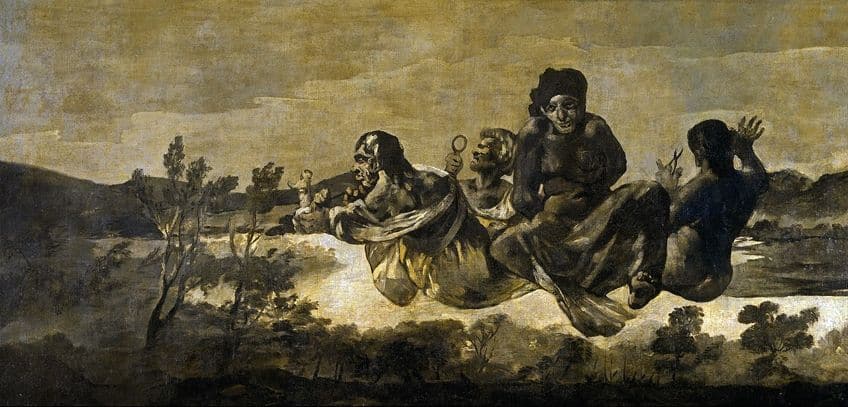
These works of art were made in Goya’s personal house, Quinta del Sordo, and were not meant for public exhibition. Goya was instead able to communicate his deepest emotions and concerns through these personal and reflective paintings. The Black Paintings by Francisco Goya indicated a shift from his earlier years’ typical academic approach. Rather than adhering to the guidelines and standards of the court and the Spanish art establishment, Goya took a more independent and unconventional approach to art.
The Black Paintings’ rawness and intense emotion significantly broke away from the era’s traditional standards.
Reception to Goya’s Black Paintings
Goya created these pieces during a time in his life when he had retired from public life and was going through both political and personal turmoil. These works of art were not discovered and well-recognized until after Goya’s passing. When the Black Paintings were eventually made public, they elicited a range of reactions. Some critics praised these pieces for their deep and honest emotional expression, characterizing them as powerful and imaginative. They were considered as a break from traditional artistic rules and influenced the development of succeeding art trends including Expressionism and Symbolism.
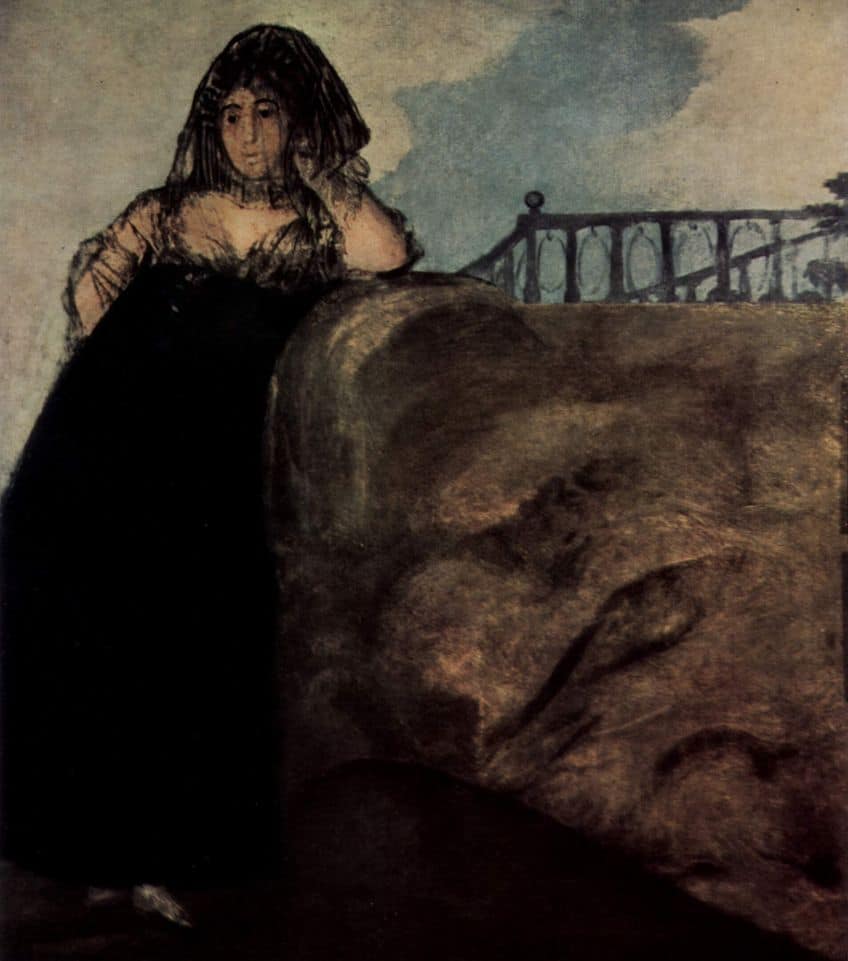
Others, on the other hand, found the subject matter frightening and unnerving, seeing the artwork as proof of Goya’s decline into lunacy. Some of the paintings, such as Saturn Devouring His Son, surprised and scared people with their violent imagery. The Black Paintings have come to be recognized as masterpieces of Goya’s final period, gaining substantial recognition for their creativity and psychological depth over the years. They are now regarded as classic and profoundly significant pieces of art, renowned for their deep examination of human emotions and the darker side of the human mind.
As we have discovered, the Black Paintings by Francisco Goya represented a significant shift in style and subject matter for the Spanish artist during the later period of his artistic output. It is reflective of a man who had grown disillusioned with the world and those who inhabited it. It was a reflection of the darkness and blackness that he was experiencing both inside of himself and around him during a very challenging time in his life. Yet, despite the horrific and depressing nature of these dark paintings, they are still celebrated for their unique style and message.
Frequently Asked Questions
Where Did Goya Produce the Famous Black Paintings Series of Artworks?
Francisco Goya created the Black Paintings in his private house, the Quinta del Sordo. It was built on the outskirts of Madrid in Spain. Goya created a series of murals by painting these works directly onto the walls of this residence.
What Is the Most Well-Known Piece of Goya’s Black Paintings?
In total, Goya produced 14 different murals at his home in Madrid. They were all subsequently transferred to canvas and now hang in the Museo Del Prado in Madrid, Spain. The most famous of these is Saturn Devouring His Son (1823).
Jordan Anthony is a Cape Town-based film photographer, curator, and arts writer. She holds a Bachelor of Art in Fine Arts from the University of the Witwatersrand, Johannesburg, where she explored themes like healing, identity, dreams, and intuitive creation in her Contemporary art practice. Jordan has collaborated with various local art institutions, including the KZNSA Gallery in Durban, the Turbine Art Fair, and the Wits Art Museum. Her photography focuses on abstract color manipulations, portraiture, candid shots, and urban landscapes. She’s intrigued by philosophy, memory, and esotericism, drawing inspiration from Surrealism, Fluxus, and ancient civilizations, as well as childhood influences and found objects. Jordan is working for artfilemagazine since 2022 and writes blog posts about art history and photography.
Learn more about Jordan Anthony and about us.
Cite this Article
Jordan, Anthony, ““Black Paintings” by Francisco Goya – Goya’s Black Paintings.” artfilemagazine – Your Online Art Source. June 19, 2023. URL: https://artfilemagazine.com/black-paintings-by-francisco-goya/
Anthony, J. (2023, 19 June). “Black Paintings” by Francisco Goya – Goya’s Black Paintings. artfilemagazine – Your Online Art Source. https://artfilemagazine.com/black-paintings-by-francisco-goya/
Anthony, Jordan. ““Black Paintings” by Francisco Goya – Goya’s Black Paintings.” artfilemagazine – Your Online Art Source, June 19, 2023. https://artfilemagazine.com/black-paintings-by-francisco-goya/.



